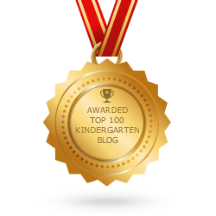Learning about landforms:
 |
| We use this bulletin board to help us label our landforms. |
Then We Sing About Them...
 |
I change the verses around to go with the landforms
or bodies of water that I'm teaching that day. |
There isn't a mountain high enough,
There isn't a valley low enough,
There isn't a hill round enough,
To keep me from coming to school!
There isn't a lake wide enough,
There isn't a river long enough,
There isn't an ocean deep enough,
To keep me from coming to school,
To keep me from coming to school!
You can add hand motions too:
Mountain - hands above head to create a pointy mountain.
Valley - hands move down & forward with palms down.
Hill - fingers laced, move hands from left to right to form curved hills.
Lake - begin with palms together and move hands apart.
River - both hands, palms facing each other, create the curve of the river.
Ocean - roll hands and move them downward.
How We Begin The Unit:
 |
Each clip has cork on the sides. My friend added the flowers.
I wrote the names with a fine tipped Sharpie. |
Using these cute clothespins I got from a friend, students pin their clothespin on the landform poster they think is their favorite. After the unit, we will do this activity again to see if anyone changes their mind. This activity generates oral language skills and gets kids talking about the features of each landform.
 |
| Students clip their clothespin to the landform poster they like best. |
 |
| Students come up in small groups of 3-4 to discuss their choices. |
Parts of the unit:
After listening to informational text about each landform,
students illustrate their concept of that landform.
We do one a day for four days and we cover mountains, hills, valleys, and plains.
 |
We illustrated one landform each day after we looked at pictures
and listened to informational text about that landform. |
We add these illustrations to our bulletin board and add some cute craftivities to them too.
 |
| This Native American was placed on the river on the bulletin board. |
The following week, we did the same thing with bodies of water: lakes, rivers, and oceans.
 |
| I also showed the students overhead images of these bodies of water. |
The third week, we create a process grid using photographs of landforms and bodies of water. Photos might include images of the different landforms and activities you might do on those landforms like skiing on a mountain, rolling down a hill, or planting crops on the plains.
 |
I took the children out to a hill on our playground and they got to roll down to the bottom.
That's something that less than half of my students had ever done before!
We compared that hill to the mountain off in the distance. |
The grid will be made of a table with 3 columns and 7 rows. Photographs of the 4 landforms and 3 bodies of water can be placed on the first column with rolled tape. Then, students come up to pick a photograph of something you can do on that landform and place them in the 2nd column. The teacher can write a fun fact in about each landform and body of water in the 3rd column like "The Pacific Ocean is the largest ocean in the world."
Culminating the unit:
The goal of this unit is to teach about the features of each of the major landforms and bodies of water, but also that the earth is nearly 70% water.
To help students realize this, we play the "Land or Water" game with a globe beach ball.
I toss the globe ball out into the class and ask the student who caught it where their thumbs landed.
I make a T-chart and we tally the number of times our thumbs land on water and how many times they land on land. Students will soon see that their thumbs land on water most of the time because the earth is mostly covered with water.
 |
This was the only image I had of our globe ball.
She is dressed up like a teacher for her
"Future Career" report. |
We also created mountains, hills, valleys, and plains out of clay.
 |
Once you make a mountain, you can have the children pour a
little bit of water down the mountain to see how water flows. |
Back to our clothespins...
Now that the students have learned a lot about the different landforms, they take their clothespins and re-clip them on their favorite landform. Most of the children will change their mind from the beginning of the unit. This, again, will generate oral language as students discuss their choices.
I'm so glad that my friend gave me these clothespins. We will use them in the same way when we cover our unit on weather and students will clip their favorite weather before and after the unit. We will also use them when we learn about community helpers and animal groups.
 |
Before we got our cool clothespins, we used mini Post-its to
indicate which poster we liked best.
I think the clothespins look much better and they provide small muscle exercise. |
You can find lots of FUN ideas in my TPT store
where there are more than 15 FREEBIES:
Check out our Pinterest Boards too:
Follow KFUNdamentals on Facebook
See you all tomorrow.
Palma :)


















































































